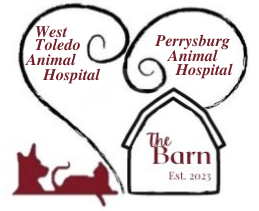Pet Pain Management
Pain Management for Pets
Pain management can be difficult, since your pet cannot tell you when they are in pain like people can. We can help manage your pet's pain here at West Toledo Animal Hospital using various methods.
Signs Your Pet is in Pain
It can be difficult to tell if, and when, your pet is in pain. Here are some signs to look out for that can mean they are in pain:
- Excessive panting
- Quick movement of muscles
- Head low to the ground
- Body shakes
- Back that is arched
- Stop eating and drinking
You might also observe some changes in your pet's behavior that can be caused by pain, such as:
- Restless moving around
- Withdrawing from you
- Aggressive behaviors
- Being more vocal
- Licking more than usual
Your pet may also show other signs that they are in pain. These avoiding jumping, limping, not wanting to get up or lie down, and walk slower than usual. If you see any of these symptoms or a combination of them, please come into our office so that we can diagnose and treat your pet's pain.
Causes of Pain in Pets
There are various causes of pain in cats and dogs. These include various conditions and illnesses like dental disease, pain from surgery, joint and bone damage, certain cancers, injury to muscles and other soft tissue, upset stomach, strains and sprains, urinary tract infections, back and neck issues, skin, and ear infections. We can diagnose and treat these conditions, along with managing your pet's pain.
Benefits of Pain Management
Having your pet's pain professionally managed by one of our veterinarians has many benefits. The most obvious one is reducing and eliminating the pain they are in. By managing your cat or dog's pain, we can also eliminate negative physical and behavioral changes you notice in your pet.
X-rays are an excellent way to help examine the hard structures within your pet's body. X-rays take an image of the body to help determine if something is amiss in your pet's structure. Just like people, X-rays can be used to help diagnose broken bones or dislocated joints. Similarly, X-rays can determine genetic disease such as hip dysplasia. X-rays can also be beneficial for diagnosing blockages within the intestines or stomach, as well as the nature of some growths and tumors. Further, X-rays can be used for pregnant animals to determine the number of puppies or kittens.
Types of Pain Management
We offer many ways to manage your pet's pain. These include massage, medications, heat and ice packs, acupuncture, chiropractic therapy, supplements, physical therapy, and laser therapy. We may use a combination of these to control and reduce your animal's pain. We can also add or reduce types of treatment based on periodical checkups with your pet.
While X-rays are certainly useful, they are only able to examine the hard structures in your pet's body. For soft tissues and organs an ultrasound is usually recommended. An ultrasound uses pulsating waves to generate an image of the body's soft tissues. This is perfect for examining different organs in the body such as the kidneys, heart, lungs, or liver. Ultrasound is painless, and the images can be interpreted in real time.
How We Can Help
Keep a record of any physical and behavior changes so that we can discuss these at your dog or cat's first visit with us. We can perform a physical, along with blood tests, diagnostic tests, and X-rays if needed. Then we can determine the type of pain management program we plan to use to help manage your pet's pain. Our veterinarian may advise you to reduce or stop physical activities with your pet, such as using steps and ramps, going on shorter walks, rolling a ball instead of throwing it long distances, and changing the height of their water and food tray.
Sometimes a pet will develop a growth or a tumor of an unknown substance. Our veterinarian will commonly take a small sample of the tumor to be sent to the lab for testing. A panel of diagnostic tests will be performed on the sample in order to determine the makeup of the particular growth. This can be used to determine if a growth is benign or malignant and can often lead to a quick diagnosis and potential treatment.
Make an Appointment
Please contact our office to make an appointment at your earliest convenience so that we can help manage your pet's pain.









Share On: